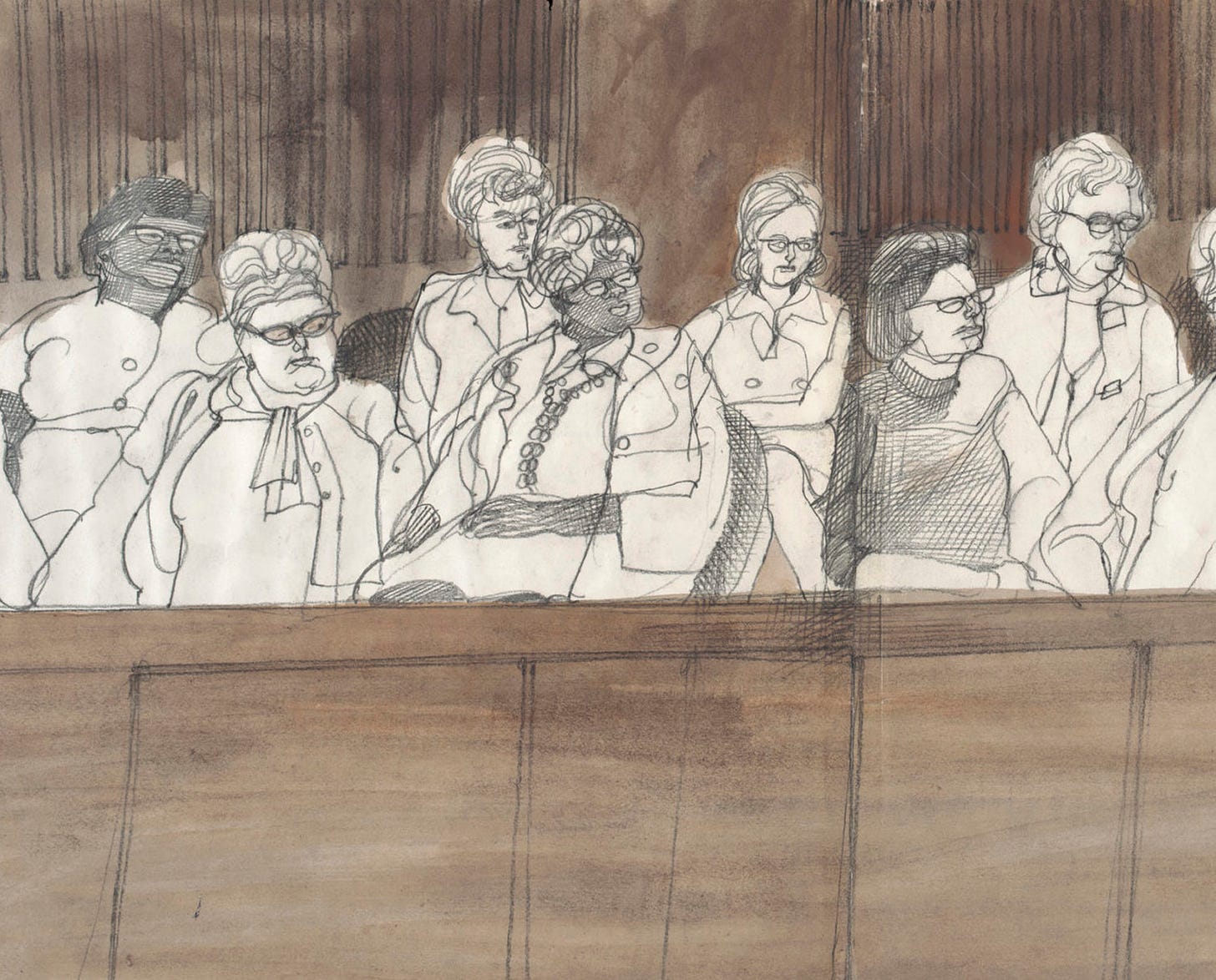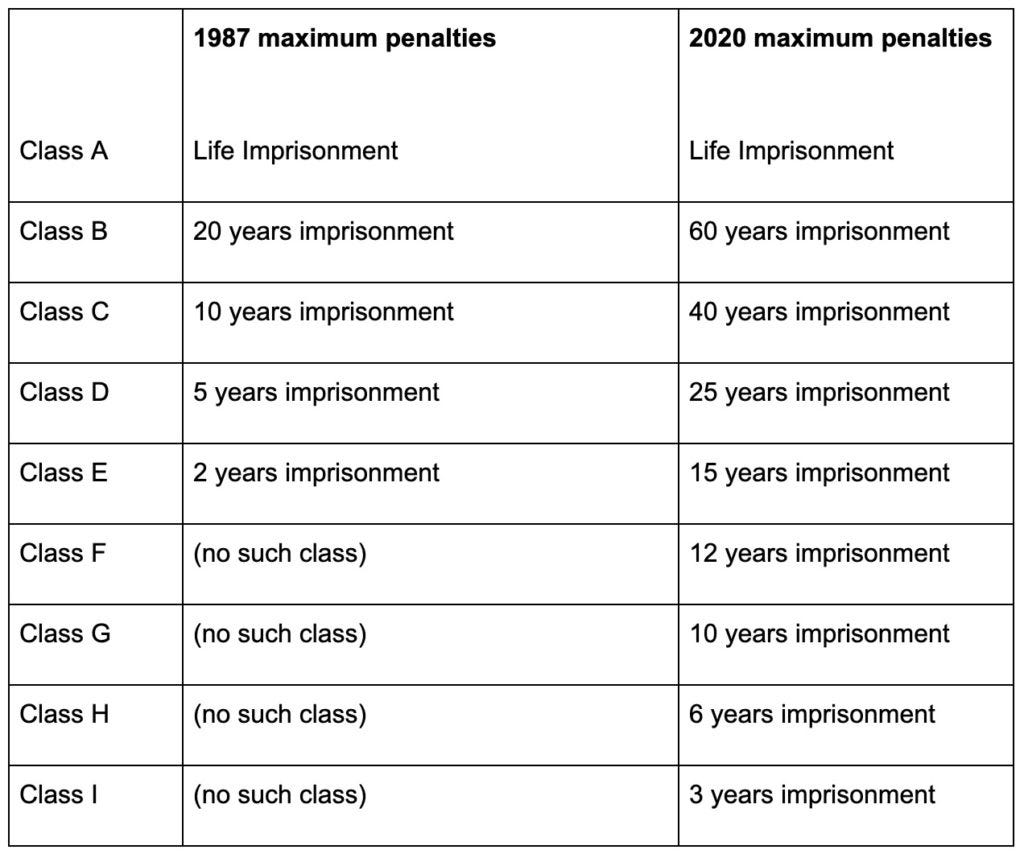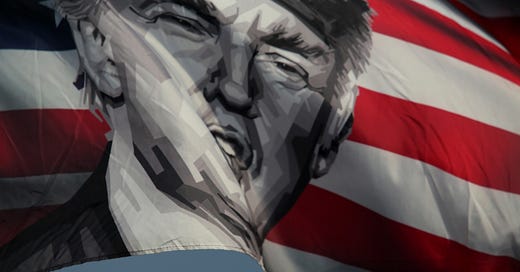
We Need More Trials By Jury
The jury trial is the original citizen oversight panel. We need more of them.

Activists spurred by the recorded murder of George Floyd are seeking to reform the two ends of the criminal justice system: the entrance (street level policing) and the exit (sentences rendered by judges). What’s missing from our national conversation is a demand for the revival of the most democratic element of the entire criminal justice system: the jury trial.
Because despite what you see on TV courtroom dramas, the criminal jury trial has been nearly extinguished from American courtrooms.
Juries are the original “citizens oversight panel” of the exercise of governmental power.
The Framers of the Constitution clearly understood the importance of the jury trial and ensconced jury trials into the Bill of Rights as the Sixth Amendment. The inclusion of the right to jury was not a new concern. It was listed among the criticisms of King George’s despotism in the Declaration of Independence, right alongside grievances about taxation without representation. (“For depriving us in many cases, of the benefits of Trial by Jury.”)
But jury trials have been nearly extinguished from American courthouses. According to the National Association of Criminal Defense Lawyers only 3 percent of state and federal cases go to trial. Which has made the American criminal courts a “system of pleas” rather than a “system of trials.”
How did this shift take place?
The dominance of the plea agreement is less the result of superior policing than shifts in penalties, overlapping criminal statutes, and the tacit agreement between prosecutors and judges to penalize defendants who take their case to trial and lose.
In other words, jury trials have been killed off by both legislative and bureaucratic pressure applied by the state against citizens charged with crimes. And because the blunt pressure of increased sentences disproportionately affects black and brown defendants across the country, this “system of pleas” is indeed indicative of an entire criminal justice process rife with inherent racism.
Starting in the mid-1980s, America’s “War on Crime” was put on steroids. Criminal penalties increased nearly across the board in most states and federally. For instance, in Wisconsin there were 300 percent to 700 percent increases in some penalties by felony classification.

Consider the following scenario: Stacy owns a failing hair salon with a substantial mortgage and modest insurance policy. In a moment of mental distress, she starts a fire in the salon’s attic at midnight. Minor damage ensues and no one is hurt. She later confesses and is indicted by the federal government. If Stacy and her attorney believe a trial is warranted to decide whether she is relieved of criminal liability because she was suffering from a mental disease and could not conduct herself according to the law (i.e. “not guilty by reason of insanity”) she has a huge wager to make.The lifting of the ceilings of potential punishments created huge, coercive leverage for prosecutors. With the potential risks to defendants so high, prosecutors could offer deals by either striking a particular charge with a larger potential penalty, or agreeing to argue to the sentencing court for a particular penalty far under the maximum. And defendants came to understand that if they failed to take these deals and lost at trial, then the sentencing court was likely to impose the largest potential penalties.
Under federal law, simple arson carries a 5-year mandatory minimum sentence.
However, nearly all federal prosecutors will also issue an additional charge of “arson in furtherance of a felony” if the case goes to trial. And arsons almost always have a “furtherance of” purpose that is felonious. After all, why else would you start a fire unless it was in pursuit of debt-relief, an insurance payout, or to maliciously destroy someone else’s property?
However, this second arson charge carries its own 10-year mandatory minimum sentence on top of the original 5-year penalty of the simple arson charge. Which raises the stakes from a potential 5-year prison stint to 15-years.
Creating these sorts of overlapping charges is the equivalent of the government stacking the deck against defendants in an attempt to get them to give up their right to a jury trial.
Which may be good for conviction rates, but may not be helpful for the cause of justice.
Another example is overdose death cases. (Or “Len Bias” homicide; this is a particular hobby horse of mine.)
Following the cocaine overdose of NBA draft pick Len Bias in 1986, the federal government and most states created a new class of homicide liability for those who deliver a controlled substance where the use of the controlled substance results in death.
These Len Bias laws were mostly dormant and unused until the current opioid epidemic surfaced, at which point prosecutors began charging homicides in cases that clearly did not warrant them.
Consider the following common fact set: Jack and Diane are heroin addicts. One afternoon, Jack calls Diane and asks if she knows where they could obtain heroin. Diane has the phone number of an active drug dealer. Jack has a car to drive to the area where the dealer wants to meet. He also has enough money to buy heroin for both himself and Diane (giving a gratuity in turn for finding the source of heroin is common in drug-user culture). The transaction happens in a parking lot and soon after both Jack and Diane use the heroin. Due to physiological differences inherent to every human, Diane gets high, but Jack suffers an overdose and dies, despite Diane’s attempts to revive him and calling 911 for medical aid.
Relying on the letter of the law, prosecutors will regularly charge the surviving heroin user with homicide under the Len Bias law.
Meaning that Diane is on the hook for murder because heroin was delivered (aiding and abetting the delivery through connecting with the actual, commercial drug dealer) and the heroin use resulted in death. These charges are facially absurd to most outside observers given the “victim” and “murderer” were partners engaged in the exact same behavior prior to one’s death. But even so, this is how the law is often applied—with the common result being that Diane will plead to a lesser charge rather than take a chance with a jury where she is on the hook for murder.
Despite the blatant injustice Len Bias prosecutions present, they are still pursued. Prosecutors are under pressure both by the public (often vocal family members of the survivors) and law enforcement community (often those engaged in multi-agency “task forces” with grant justification motivations) to seek convictions.
Another common example of unjust prosecutions are those for “resisting or obstructing” an officer.
Here is another common fact set: John, an African-American male, is driving home from visiting his mother. John drives a newish car. A police officer, ostensibly monitoring traffic, clocks John driving over the speed limit and pulls him over. John correctly points out that several cars passed him in close proximity to the officer and asks whether the officer pulled him over because of his race. The officer asks that John exit his car. John, who has committed no arrestable offense, balks.
Other officers arrive as “backup” and together decide that John’s unwillingness to leave his own car is further justification to force him to do so. The officers then physically snatch John from his car and “decentralize” him. (There is an entire lexicon of terminology used by law enforcement in the vein of “decentralize”—which is simply the bureaucratic way of saying “throw the person to the ground.”)
As any human would, John pushes away from the police officers in an attempt to protect his person. In the process, one of the officers sprains his thumb.
John is then arrested and charged with a felony resisting an officer for causing soft tissue damage.
Prosecutors, who have to deal with the same police officers every day and rely on them to make their cases, will have a professional incentive not to “budge” on the prosecution. After all: John is just a one-time actor in the prosecutor’s professional life. The police who are charging him are repeat players.
In other contexts this, this sort of asymmetrical relationship between supposedly independent entities might be called “industry capture.” It’s a lot like the situation we see in regulation when the regulators are led around by the same interests they are charged with overseeing.
What all of these examples have in common is that reforming the entrance to and exit from the criminal justice system can only take us so far.
Only the middle phase—the jury trial—has been reliably effective in holding the state to account, because they allow ordinary citizens to put their thumbs on the scales of justice and acquit those being pursued by overzealous prosecutors. Only after being socked in the nose several times with the words “not guilty” will prosecutors be persuaded to curtail particularly noxious avenues of unjust prosecutions.
But the pressure valve and correcting ability of the original citizens oversight panels cannot be revived unless prosecutors and courts buy-in to their constitutional duty to allow jury trials without making the potential penalties from a conviction wildly out of sync with the alleged crime.
After all, you could get a 100 percent conviction rate if the potential penalty for every crime was death, because no reasonable defendant would dare take a case to trial. But that wouldn’t be justice any more than the current system of overcharging is.
And the state’s goal isn’t getting as many convictions as possible. It’s furthering the cause of justice.
So while we attempt to reform law enforcement, we should also try to reform the trial system:
Eliminate the ability of prosecutors to stack redundant charges.
Stop prosecutors from seeking penalties grossly beyond those sought during the pretrial plea bargain process.
Train prosecutors to accept trials as normal and expected.
Allow defense attorneys to expressly question the justice of tried charges (engaging in so-call “jury nullification”).
And ratchet down sentencing penalties and eliminate overlapping criminal offenses to create a criminal justice system in line with the Framers’ intent.
The importance of jury trials to American liberty is not new. To quote Jefferson “I consider trials by jury as the only anchor ever yet imagined by man, by which a government can be held to the principles of its Constitution.”









